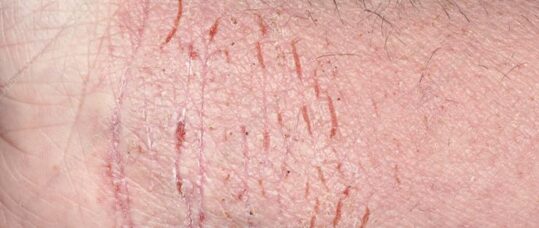Assessing new dermatology patients in practice

Sandra Lawton with steps you should take when assessing a patient with dermatological complaints
When patients present with a skin problem the principles of taking a comprehensive history and performing an assessment apply. The fundamentals of a dermatology assessment should include the following.
Taking a dermatological history
- Past medical history – does the patient have any chronic medical problems or recent illnesses, which may suggest a systemic cause for the rash? Acute illness: headaches, fever, weakness. Chronic illness: fatigue, malaise, anorexia and weight loss.
- Family history of skin disease and autoimmune conditions or recent contact with individuals with a rash (scabies, chickenpox) – do any family members have the same or similar symptoms?
- Medications (past and present) – oral and topical applications. Were these prescribed, purchased over the counter or on the internet? Were they borrowed? How effective have they been? Have you recently started any new medicines? Consider a possible drug reaction, asking about the duration of use (recently used or long-term use). Have any of the medications used improved the condition?
- Allergies – consider drugs, foods, airborne allergens, contact allergens (products used on the skin). Also ask about possible exposure to occupational and recreational allergens and hay fever and asthma.
- Other treatments or actions the patient has tried to solve the problem – homeopathy, sunbeds, dietary measures.
- Trigger factors – does anything appear to make the problem worse, does it vary at different times of year?
- What impact do work, school and hobbies have?
- Social history and habits – smoking, alcohol and drug abuse, sexual history and travel.
- Is it a rash or lesion?
- Onset – when did the rash or lesion appear? What did it first look like? Where was it? What were the symptoms? Does it itch or hurt (pain and soreness)? Has it changed?
- How has it spread and in what pattern – does it come and go? Has it been persistent or changed over time with flares and remission? Have you used or done anything that seems to make it better? In the case of a persistent single lesion, has its appearance recently changed? Has there been rapid growth, colour change or bleeding or has it stayed the same?
Recognising the impact skin conditions have on the patient’s quality of life
Related Article: Weight loss medication is no magic wand
Common skin diseases are associated with significant psychosocial morbidity and should not be understated. Skin diseases can have a major impact on the lives of patients and their families in terms of psychological wellbeing, social functioning and everyday activities, and that may go unrecognised without the use of appropriate assessment tools. The quality of life of people with skin diseases can be significantly impaired, and such impairment can be greater at times than for life-threatening conditions such as cancers.1 In dermatology there are questionnaires to assess the
impact the condition is having on a patient’s quality of life. They play an important part of the assessment, monitoring of treatment outcomes, and aiding management decisions, and are commonly used both in clinical practice and dermatology research.2
Performing a skin assessment
Before the examination, inform the patient that all areas of the skin will need to be looked at and be aware of their privacy, dignity, religious and cultural upbringing. The skin examination should be undertaken in a warm well-lit room, ideally with natural light. Additional light sources and magnification may also be required. Examinations should be done in an orderly manner to ensure important clues are not missed. Touching the skin is a fundamental aspect of the assessment – observation alone will not provide the detail required.2
Don’t overlook hair, nails, and mouth. The general examination of the skin considers normal variants and general changes in the skin. General changes can alter colour (jaundice, cyanosis, pallor), turgor, thickness, temperature, and vascularity (purpura, petechiae, flushing).
Describing dermatology terminology
Specific terminology is used for the characteristics of skin lesions (colour, configuration, distribution and morphology), which can then be documented:
- Configuration – the arrangement or pattern of lesions in relation to other lesions.
- Distribution – the arrangement of lesions on an area of skin.
- Shape and colour.
- Morphology – the form or structure of an individual lesion.
- Type – primary (present at the initial onset of the disease) or secondary lesions. Secondary lesions result from changes in primary lesions caused by disease progression, manipulation (scratching, rubbing, picking) or from treatments.
Having an understanding of the additional tests that may be required
Other diagnostic tools offer key information in making a diagnosis.
Related Article: Prescribing in England to be led by a single national formulary
Sandra Lawton is a nurse consultant in dermatology at Rotherham NHS Foundation Trust
References
1 Schofield J, Grindlay D, Williams H. Skin conditions in the UK. A health care needs assessment. Centre of Evidence Based Dermatology; University of Nottingham: 2009
Related Article: Advice on Guillain-Barré risk for adult RSV vaccine updated by MHRA
2 Lawton S. Assessing a patient with a common dermatological problem. Primary Health Care 2016;26:42-9
Resources
- Quality of life questionnaires cardiff.ac.uk/dermatology/quality-of-life/
- Primary Care Dermatology Society pcds.org.uk/p/skin-disease-examination
- Terminology in dermatology dermnetnz.org/topics/terminology/
- Dermatological investigations and tests: dermnetnz.org/topics/dermatological-investigations-and-tests/

See how our symptom tool can help you make better sense of patient presentations
Click here to search a symptom


Sandra Lawton with steps you should take when assessing a patient with dermatological complaints



